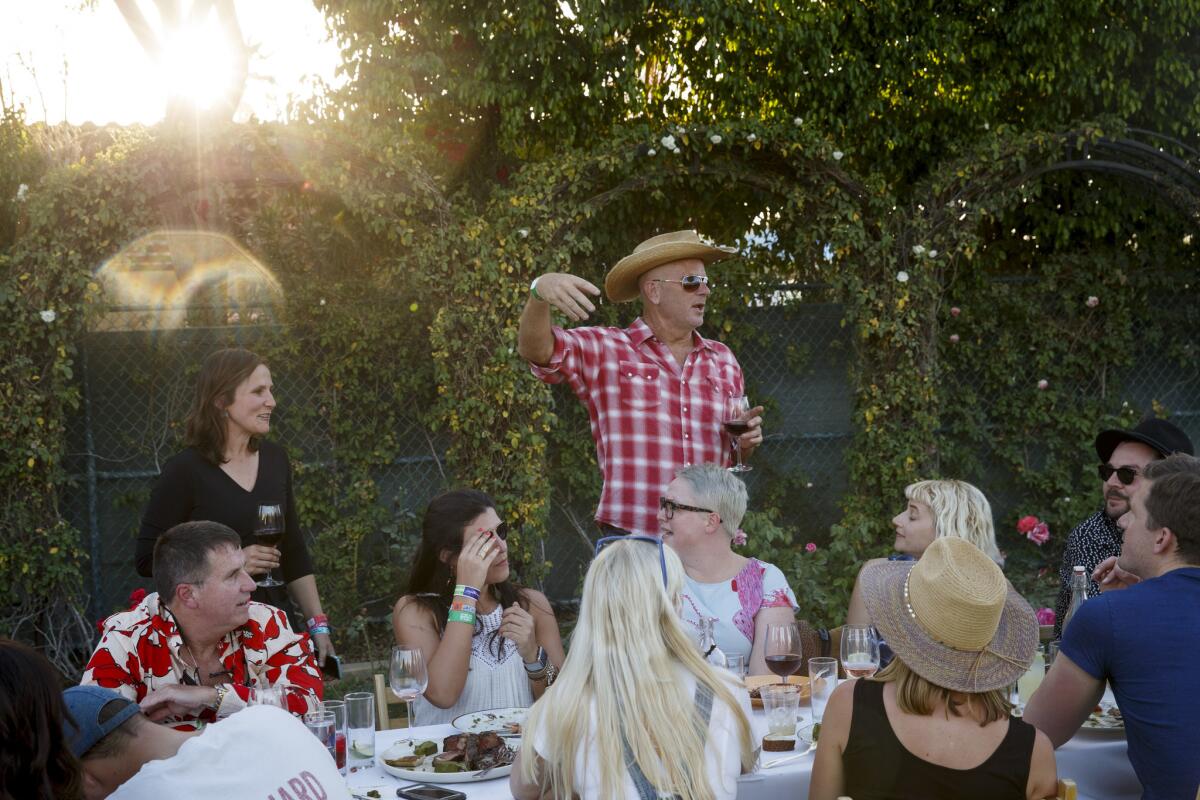This chef has put on pop-up dinners in 15 countries and all 50 states

There’s farm-to-table dining, and then there’s table-to-farm.
Outstanding in the Field, a roving restaurant-without-walls, brings guests straight to the source, presenting seasonal, site-specific meals in the farms, gardens and groves where the food was raised and harvested. Founded in 1999, it has since toured all 50 states and 15 countries, collaborating with hundreds of chefs and farmers. At each dinner, a communal table communes with nature, snaking through blades of soft grass or following the curve of a shoreline. Guests sit beside the people who grew their food. Founder Jim Denevan calls it “a picture of place.”
That Denevan offers an artistic metaphor is not surprising. Born in San Jose, Denevan worked in restaurants and on his brother’s organic farm as a teenager, but by the time he was executive chef at Gabriella Café in Santa Cruz in the mid-’90s, he’d also become an artist, creating drawings in the sand designed to be transformed – and ultimately erased – by waves, wind and weather. He practiced his land art at every low tide with the same kind of obsession, he says, that he brought to launching Outstanding in the Field.
Beginning with Outstanding in the Field’s first dinner, which he set on a local farm between a wall of ripe tomatoes and flowering gladiolus, to the present season, which includes four Food Bowl events at Manhattan Beach, Grand Park, Autonomy Farms and Weiser Family Farms, each meal elevates the idea of experience, a one-day-only, never-to-be-repeated moment in place and time. The Manhattan Beach event, which will serve more than 300 guests, takes inspiration from the Pacific, while Grand Park revitalizes a city space, Autonomy Farms recognizes women in the field and in the kitchen, and Weiser Family Farms captures the culinary and land art traditions of Peru. For Denevan, each dinner is its own piece of temporal art: He sees the geometry of a table as an extension of the natural geometry of a beach, park or farm, and the settings, food and people working in concert.
Recently, in between creating land art for the Form Festival in Arcosanti Arizona and an event at none-other-than Coachella, Denevan took a break to talk about chefs and farmers, composing outdoors, moonrises and the solar eclipse.
This conversation has been edited for length and clarity.
Is your art practice distinct from Outstanding in the Field, or are they part and parcel?
When I’m arranging a table in an outdoor environment, and it’s a curve or a straight line or some variation, it’s very similar. A table’s not in isolation, it’s placed to fit in the landscape, so really, arranging a table in a field feels like composing outdoors. I want people to come over a hill or go along a walk to a table and experience this reveal and discovery, so the length of the walk is also part of the composition. I love thinking of the potential for the particular day, and that goes for the weather.
The weather is part of the composition too?
Questions of weather are so essential. You don’t have a table in direct sun when it’s over 77 degrees, the event doesn’t take place when the sun’s overhead. You can also arrange the table so that the sun sets directly down the center of the table, which is really powerful. That’s all planned. For the dinner at Alex Weiser’s place, the next day is the full moon. It’s possible to align the table so that, simultaneously, if you look one way down the table it’s sunset, and if you look the other way it’s moonrise.
The sun and moon are part of your composition? That’s wizardry. What artistic elements do you have planned for the Manhattan Beach event?
That beach is pretty phenomenal for a new kind of sand art: It’s visually really spectacular, and somewhat sculptural. There’ll be hills that start the size of a sand castle, about a foot high, and then they slowly get larger and larger as you’re farther from the center, and the table will run all the way around that on the outer edge. I got pretty excited about that.
How do the chefs fit into all this?
To use an artistic analogy, there’s a selection for their palette. The dinners exist for that day – we literally set everything up and take everything away on the same day – so I ask the chefs to not write a menu until a few weeks before. I want the inspiration of the moment.
And the farmers?
These are workplaces for the farmers, and it’s a time to push the farmer forward. We think of the chef as being a creative person that sustains us, but those who work the land and live off of the rhythms of nature can communicate that being connected to place, and the meaning of place, is good for people. For instance, the Manhattan Beach event: Most people don’t think about the Pacific Ocean in the context of Southern California as being “productive.” They think it may be polluted or a place to go surfing, but they may never think that it’s actually a place where a great number of people make their livelihoods. When the fisherman is present at the event, they can point out, “I was over there. That’s where I dove for that urchin.”
Your artwork and dinners are designed to be impermanent. What is it about the ephemeral that feels essential to your work?
I think about the solar eclipse that happened recently, and people’s effort to be present at a moment when heaven and earth and the elements had a specificity: “This is today. This is not yesterday and this is not tomorrow.” There’s poetry to being present within the dance of nature.
Is that what Outstanding in the Field is all about?
We can talk about people getting in touch with place and where their food comes from, hearing the farmer’s stories and seeing the chef’s creativity in a wild environment, but when it comes down to it, it’s the human connection at the table. It makes me think of the Last Supper and hard work over the centuries and how powerful it is that people sit together. What a moment it’s become: the presidency, the polarization, social media, “us and them.” Sitting at the same table, people can have different kinds of conversations than they do with their self-selected friends. To physically be there and actually talk to people and share a meal – it’s always going to be powerful, but it’s particularly powerful in this moment. It’s so damn down to earth that it makes people feel comfortable.
Food Bowl Alert: Jim Denevan will be featured at multiple Outstanding in the Field dinners at this year’s Los Angeles Times Food Bowl. On May 16, Denevan will host a Filipino feast during Night Market at Grand Park at 6 p.m. Tickets are $235. On May 24 he will host a sustainable seafood dinner in Manhattan Beach with Michael Cimarusti at 4 p.m. Tickets are $235. On May 27 he will host a dinner at Autonomy Farms with Bricia Lopez at 4 p.m. Tickets are $225. And on May 28 he will host a dinner with Virgilio Martinez at Weiser Family Farms at 4 p.m. Tickets are $235.
Eat your way across L.A.
Get our weekly Tasting Notes newsletter for reviews, news and more.
You may occasionally receive promotional content from the Los Angeles Times.




